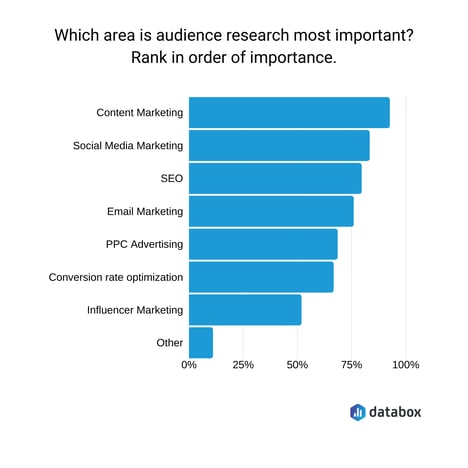
Marketers use audience analysis to gain a deeper understanding of audiences. They create accurate, detailed buyer personas with knowledge of the needs, interests, and pain points of the target audience. This helps them formulate a marketing plan that aligns with the audience’s values and characteristics.
Marketing depends on audience engagement, which in turn, depends on high-quality content and the right metrics. An engaged audience boosts a brand’s marketing effectiveness.
Previously, it was possible to understand the audience only through surveys and market research data. Now, you can perform audience analysis with alternative datasets and social media data to get actionable insights.
What is audience analysis and engagement rate?

Source: Databox
Databox found that audience research was most helpful with content marketing, social media marketing, and SEO efforts.
Audience analysis involves collecting information about your audience to gain a deeper understanding of the needs and preferences of current and potential customers. It helps improve marketing strategy, user experience, and brand perception.
Here, audience refers to the people who consume your content or buy your products and services.
Audience analysis is central to any marketing strategy because it provides an in-depth view of who your audience is. It also tells you who is not your audience and how you could modify your strategy to reach new audiences.
Thus, audience analysis provides valuable consumer insights in the form of buyer personas, which are semi-fictional representations of your ideal customers.
Complete audience analysis involves the following metrics:
- Demographics - classifies an audience based on demographic characteristics like age, gender, socioeconomic status, or location.
- Psychographics - classifies an audience based on their attitudes, interests, and opinions.
- Prior Knowledge - classifies an audience based on their preconceived perceptions, assumptions, and interpretations.
- Engagement rate - classifies an audience based on how actively involved they are with your content.
Audience analysis is essential to help you know where to focus your marketing efforts. What are the core pain points that your product or service solves? Where does your target audience hang out? What do they care most about?
When you can use on-page and off-page engagement data to identify audience members as closely resembling a specific persona, you can find opportunities to optimize your website’s content for each of your audience segments. With this type of experimentation in place, maximizing your various landing pages’ conversion and engagement rates becomes far more straightforward.
Types of audience analysis
Audience analysis can take many forms. It helps to go beyond understanding the basic demographics of your target audience to the finer details of consumer preferences for your products or services.
There are several types of audience analyses:
- Social audience analysis - involves using social media analytics data about active users to understand your audience.
- Branded audience analysis - focuses on looking at the audience of a specific brand (your own or your competitor’s) to understand what makes them support the brand.
- Unbranded audience analysis - involves looking at the audience to identify shared interests in a general product type and related topics, such as technology, fashion, or computers.
- Competitor audience analysis - involves categorizing audiences based on the brands they mention (and follow) and determining who talks about your competitors and what their preferences are. You can derive valuable insights on industry trends and opportunity gaps to fill by examining audiences that follow your competitors.
- Demographic audience analysis - focuses on segmenting and analyzing audiences based on demographic characteristics like location, age, and gender. Most buyer personas revolve around a demographic analysis. Location often plays a big role in determining a brand’s seasonal performance.
- Psychographic audience analysis - focuses on analyzing audiences based on interests, affinities, and values. It gives a fuller picture of what audiences care about.
For example, information about your audience’s hobbies, political tendencies, social engagements or values like patriotism, honesty, and freedom. If you can align your messaging with your audience’s beliefs, they are more likely to support you.
Why is audience analysis important?
Audience analysis enables you to intercept your prospects and customers with clear and targeted messaging during the buyer journey. It helps you determine who to tailor your content to and how to craft marketing campaigns to generate the highest engagement.
Personalization and accurate audience targeting improve the user experience. Consequently, it boosts customer loyalty and improves brand perception and recognition.
Here are a few ways in which audience analysis can benefit you:
a) Track trends in audience interests
Audience interests keep shifting and affect their decision-making. By tracking them and identifying trends before they become saturated, you can capitalize on them to generate more engagement and visibility.
Audience analysis helps you understand the underlying causes of the changes in your audience’s search interests. Thus, you can leverage these trends in your favor.
b) Identify trending topics
Which topics will hit the mark with your audience? Good topics should be geared toward your audience’s core needs and interests and should also match with your expertise.
Audience analysis helps you pinpoint niche topics that your audience is most likely to respond to than others. Thus, you can frame your marketing messages to suit them.
Targeted content creation generates more engagement and boosts visibility, keeping you top of mind when your customers look for solutions.
c) Identify preferred channels
Audience analysis helps you understand where your audience is and through which channels they prefer to consume content. For example, you would tailor your messaging to the most preferred social media platform of your target audience.
Social media platforms are not the only place where your audiences could be talking about you. Community forums, blogs, review sites, and news sites are all thriving spots to reach your audience.
Tips to conduct audience analysis
Now that you understand the importance of audience analysis in improving engagement, let’s see how you can identify your audience characteristics.
1. Use audience analysis tools
Social media provides you with a goldmine of information about your audience. But the sheer volume of data due to the explosion of social media channels makes it impossible to effectively analyze it manually.
Audience analysis tools assist you in the process by monitoring audience insights. They show you where your customers are and track referral traffic. They also monitor competitor traffic and performance closely to help you identify gaps and opportunities.
They can also help with hashtag analysis to determine what your audience is interested in and what their online preferences are.
Social media platforms also have in-house analytics like Facebook Insights and Twitter Insights that you can combine with the insights from your audience analysis tool.
2. Define metrics
There are plenty of metrics that determine audience engagement and tracking each metric is a wasted effort. Instead, pick the metrics that help you work toward your specific goals.
If you want to track audience metrics for your website, you can focus on the following:
- Sessions by country - Is your content attracting visitors from your target locations?
- Average session duration - How long are visitors spending on your website or specific pages? The longer they spend, the more likely they are part of your target audience.
- Bounce rate - Do visitors quickly leave your website after landing on it? Or do they engage with the site before leaving it? Bounce rate reveals the percentage of visits for a single page.
- Pageviews - Are visitors viewing your page(s) frequently? It’s likely your content is relevant to them.
- % new sessions - What is the ratio of first-time visits to returning visits? It tracks the number of new visitors coming to your site and the extent to which your content encourages visitors to return.
For social media, here are some important metrics to track:
- Engagement: likes, comments, shares, clicks, account mentions
- Awareness: impressions (how many times a post is displayed in a user’s timeline) and reach (the potential unique viewers of a post)
- Share of voice: how much of the online space (by volume and sentiment) your brand occupies
- ROI: referrals (the social media channel through which a user lands on your website) and conversions (how many users visited a social media channel and bought something in the same visit)
- Customer care: response time (how fast your brand responds to customer’s messages on social media) and response rate (how many customer messages your brand responds to)
3. Clarify which questions you need answers to
Determine which questions you want to be answered before you go deep into audience research. This will shape your analysis based on your specific goals and KPIs.
Your goals could be:
- To increase brand awareness
- To boost on-page engagement and micro-conversions
- To get more leads and customers
- To attract a new target market
For instance, a car manufacturer may want to understand which groups of people would be interested in the launch of a midsize car. These audiences could be targeted with different commercials through different media channels.
Another example could be a healthcare product manufacturer looking to narrow its target audience of healthcare professionals by age, gender, and geographic location. It could offer different products to each segment.
4. Connect with your audience’s influencers
Identify opinion leaders who are valued by your target audience. Social media influencers are powerful allies when it comes to gaining an engaged audience and keeping them interested.
Social listening tools like BuzzSumo & Awario can help you identify specific influencers who can build a personal connection with your target audience or boost your brand authority.

Source: IIDE
For instance, Hello Fresh, a meal kit delivery service, collaborates heavily with influencers like Mandy Moore and Audrina Partridge to market its products. It targets working women, busy mothers, and other types of busy women. The influencers insert their everyday stories into the sponsored posts to spark a personal touch.
5. Analyze competitors
Competitor analysis will help you learn from the marketing efforts of your closest competitors and figure out what works or what doesn’t. Determine if there are gaps in their product or service that your brand can fill.
Check their social media campaigns and their website content to see what their strategy is, what types of people interact with them, and what sort of content generates the highest responses.
Use competitor listening tools like Google AdWords Keyword Planner, SEMRush, SimilarWeb, or FollowerWonk (by Moz) to analyze competitors’ sites, social media, and emails and discover potential opportunities.
Compile this data along with the information you have about your current customers to increase your audience reach to new characteristics.
6. Use the data obtained to address pain points.
Once you understand your audience’s characteristics and their pain points, you can create a strategy to address them.
Create a balanced mix of product information and educational content. It will raise brand awareness, overcome objections, and encourage people to engage with you.
Audience research is an ongoing process. So, revisit it regularly to know if your understanding of your target audience is still valid. Conduct A/B testing with tools like Google Optimize or Omniconvert to determine which content approaches perform better.
Wrapping Up
Audience analysis is an important tool in knowing how to reach potential and current customers with appropriate messaging. If you’re aware of your customer’s wants and needs, they are more likely to engage with your products and services. This, in turn, builds a trusting relationship and is likely to boost conversions and sales.
Also read: How to Recognize and Manage Follower Quality


Join the conversation. Leave us a comment below!